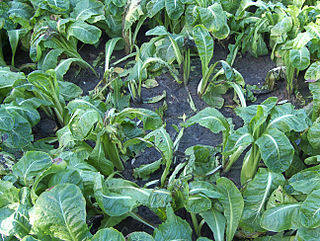
Pseudomonas is a genus of Gram-negative, Gammaproteobacteria, belonging to the family Pseudomonadaceae and containing 191 described species. The members of the genus demonstrate a great deal of metabolic diversity and consequently are able to colonize a wide range of niches. Their ease of culture in vitro and availability of an increasing number of Pseudomonas strain genome sequences has made the genus an excellent focus for scientific research; the best studied species include P. aeruginosa in its role as an opportunistic human pathogen, the plant pathogen P. syringae, the soil bacterium P. putida, and the plant growth-promoting P. fluorescens, P. lini, P. migulae, and P. graminis.
Pseudomonas alcaligenes is a Gram-negative aerobic bacterium used for bioremediation purposes of oil pollution, pesticide substances, and certain chemical substances, as it can degrade polycyclic aromatic hydrocarbons. It can be a human pathogen, but occurrences are very rare. Based on 16S rRNA analysis, P. alcaligenes has been placed in the P. aeruginosa group.
Pseudomonas fragi is a psychrophilic, Gram-negative bacterium that is responsible for dairy spoilage. Unlike many other members of the genus Pseudomonas, P. fragi does not produce siderophores. Optimal temperature for growth is 30 °C, however it can grow between 0 and 35 °C. Based on 16S rRNA analysis, P. fragi has been placed in the P. chlororaphis group.
Pseudomonas avellanae is a Gram-negative plant pathogenic bacterium. It is the causal agent of bacterial canker of hazelnut. Based on 16S rRNA analysis, P. avellanae has been placed in the P. syringae group. This species was once included as a pathovar of Pseudomonas syringae, but following DNA-DNA hybridization, it was instated as a separate species. Following ribotypical analysis Pseudomonas syringae pv. theae was incorporated into this species.
Pseudomonas corrugata is a Gram-negative, plant-pathogenic bacterium that causes pith necrosis in tomatoes. Based on 16S rRNA analysis, P. corrugata has been placed in the P. fluorescens group. For a more comprehensive phylogenetic analysis of P. corrugata and its closely related phytopathogenic bacterium P. mediterranea, refer to Trantas et al. 2015.
Pseudomonas ficuserectae is a nonfluorescent, Gram-negative, soil bacterium that causes bacterial leaf spot on a Japanese fig, from which it derives its name. Based on 16S rRNA analysis, P. ficuserectae has been placed in the P. syringae group.

Pseudomonas marginalis is a soil bacterium that can cause soft rots of plant tissues. It infects poinsettia, lettuce, and crucifers.
Pseudomonas meliae is a fluorescent, Gram-negative, soil bacterium that causes bacterial gall of the chinaberry, from which it derives its name. Based on 16S rRNA analysis, P. meliae has been placed in the Pseudomonas syringae group. Genotypic characteristics of the causal agent of chinaberry gall were determined by Aeini and Taghavi.
Pseudomonas tolaasii is a species of Gram-negative soil bacteria that is the causal agent of bacterial blotch on cultivated mushrooms. It is known to produce a toxin, called tolaasin, which is responsible for the brown blotches associated with the disease. It also demonstrates hemolytic activity, causing lysis of erythrocytes. Based on 16S rRNA analysis, P. tolaasii has been placed in the P. fluorescens group.
Pseudomonas mendocina is a Gram-negative environmental bacterium that can cause opportunistic infections, such as infective endocarditis and spondylodiscitis, although cases are very rare. It has potential use in bioremediation as it is able to degrade toluene. Based on 16S rRNA analysis, P. mendocina has been placed in the P. aeruginosa group.
Pseudomonas anguilliseptica is a Gram-negative bacterium that is pathogenic to fish. It was first isolated from Japanese eels. Based on 16S rRNA analysis, P. anguilliseptica has been placed in the P. aeruginosa group.
Pseudomonas flavescens is a Gram-negative bacterium that causes blight cankers on walnut trees. Based on 16S rRNA analysis, P. flavescens has been placed in the P. aeruginosa group.
Pseudomonas amygdali is a Gram-negative plant pathogenic bacterium. It is named after its ability to cause disease on almond trees. Different analyses, including 16S rRNA analysis, DNA-DNA hybridization, and MLST clearly placed P. amygdali in the P. syringae group together with the species Pseudomonas ficuserectae and Pseudomonas meliae, and 27 pathovars of Pseudomonas syringae/Pseudomonas savastanoi, constituting a single, well-defined phylogenetic group which should be considered as a single species. This phylogenetic group has not been formally named because of the lack of reliable means to differentiate it phenotipically from closely related species, and it is currently known as either genomospecies 2 or phylogroup 3. When it is formally named, the correct name for this new species should be Pseudomonas amygdali, which takes precedence over all the other names of taxa from this group, including Pseudomonas savastanoi, which is and inadequate and confusing name whose use is not recommended.
Pseudomonas straminea is a Gram-negative, rod bacterium that includes strains formerly identified as P. ochracea. Based on 16S rRNA analysis, P. straminea has been placed in the P. aeruginosa group.
Pseudomonas lundensis is a Gram-negative, rod-shaped bacterium that often causes spoilage of milk, cheese, meat, and fish. Based on 16S rRNA analysis, P. lundensis has been placed in the P. chlororaphis group.
Pseudomonas taetrolens is a Gram-negative, nonsporulating, motile, rod-shaped bacterium that causes mustiness in eggs. Based on 16S rRNA analysis, P. taetrolens has been placed in the P. chlororaphis group.
Pseudomonas mucidolens is a Gram-negative, non-sporulating, motile, rod bacterium that causes mustiness in eggs. Based on 16S rRNA analysis, P. mucidolens has been placed in the P. fluorescens group.
Pseudomonas plecoglossicida is a non-fluorescent, Gram-negative, rod-shaped, motile bacterium that causes hemorrhagic ascites in the ayu fish, from which it derives its name. Based on 16S rRNA analysis, P. plecoglossicida has been placed in the P. putida group.
Pseudomonas gessardii is a fluorescent, Gram-negative, rod-shaped bacterium isolated from natural mineral waters in France. Based on 16S rRNA analysis, P. gessardii has been placed in the P. fluorescens group.
Pseudomonas nitroreducens is an aerobic, Gram-negative soil bacterium first isolated from oil brine in Japan. It is able to synthesise polyhydroxybutyrate homopolymer from medium chain length fatty acids. Based on 16S rRNA analysis, P. nitroreducens has been placed in the P. aeruginosa group.

